马上注册,结交更多好友,享用更多功能,让你轻松玩转社区。
您需要 登录 才可以下载或查看,没有帐号?立即注册

x
The process of converting an RC car to a APM:Rover consists of adding the APM autopilot in between the RC receiver and the car’s motor and steering servo. We recommend that the APM be powered by the included Power Module.
(Note: this tutorial assumes you’re using a Mode 2 radio setup. If you’re using Mode 1, the throttle will move to the other stick) APM:Rover is designed to use regular RC transmitters (not specialized RC car transmitters) with both throttle and steering on the right stick. This is because RC cars can typically go both forwards and backwards and so the throttle should be spring-loaded to return to the mid-point, which is the case for the right up/down stick (typically the elevator stick) on regular RC transmitters. If, however, you are not using a RC car motor controller but rather a regular aircraft motor controller, which typically does not have a reverse function, you can put the throttle on the left stick as would normally be the case for an aircraft.
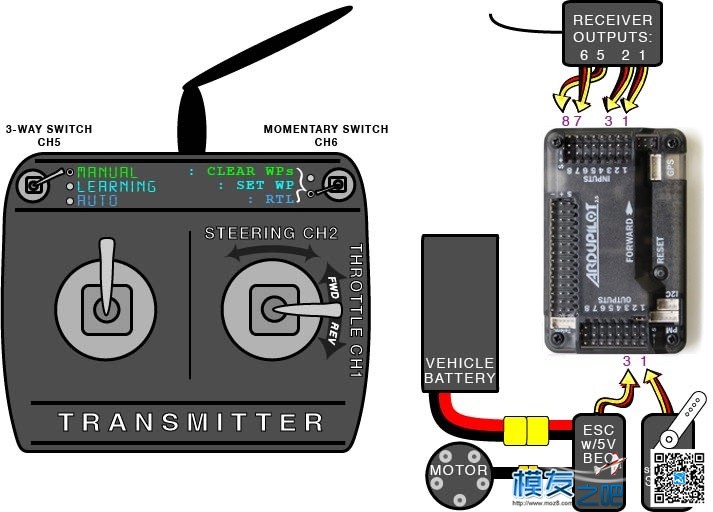
RC SetupConnect your RC system to APM as shown below: Input Channels: | RC Rx | APM Input | Function | | 1 | 1 | Steering | | 2 | 3 | Throttle | | 5 | 8 | Mode | | 6 | 7 | Record waypoint |
Output Channels: (For standard RC cars that use a servo to steer, use the Car settings. If, however, you have a treaded tank or some other vehicle that uses different speed motors on each side to steer, use the Skid Steer settings) | APM Output | Car | Skid Steer | | 1 | Servo | Left Motor | | 3 | Motor/ESC | Right Motor |
Reassigning your RC transmitter stick channels:- Although the default normal transmitter stick configuration is generally the best, APM:Rover does allow you to reconfigure them.
- To reassign the RC transmitter sticks to other than the default channels:
- Connect your APM’s USB port to your computer and start Mission Planner (ensure that Advanced View is turned on in the Config page to see all menu options) and Select the “Connect” button on the upper right..
- Select the “Configuration” tab then select “Advanced Params” and the Adv Parameter List”.
- Scroll down to the “RCMAP_ROLL, RCMAP_PITCH, RCMAP_THROTTLE and RCMAP_YAW” parameters.
- These allow you to directly assign which radio channel (1-8) is assigned to each of the major functions.
- This is useful when you have a flight transmitter with unusual channel assignments.
- Or which does not allow easy channel reassignment at the transmitter
- Additional information on these parameters may be found here.
Installing it in your carThe below shows a typical setup in a small rover, using APM, 3DR radio telemetry and both sonar and IR sensors (instructions on setting them up are here. Note a few elements: - The RC car’s plastic body shell has been removed and a plywood sheet cut and drilled to fit on the mounting posts.
- APM has been raised up on a platform made of four 30mm nylon spacers, four 5mm nylon screws, and an ArduCopter stack-up plate. This is to ensure that the sensitive compass sensor on APM is as far as possible from the magnetic noise/interference of the car’s electric motor.
- APM, the GPS, 3DR radio and RC receiver are all powered by the APM Power Module (included with the APM set). The car’s steering servo is powered by the car’s speed controller. This is the standard setup and doesn’t require any special settings or configuration, but for those wondering about power, that’s the answer. Among other advantages, the use of the APM Power Module means that APM can do voltage and current sensing and report battery status to the Ground Station during the run, as well as datalog it for after-run analysis.
- A larger battery than the car was originally designed for is being used (because the rover is designed to travel long distances off-road), and it is mounted on velcro under the APM platform so it doesn’t shift.
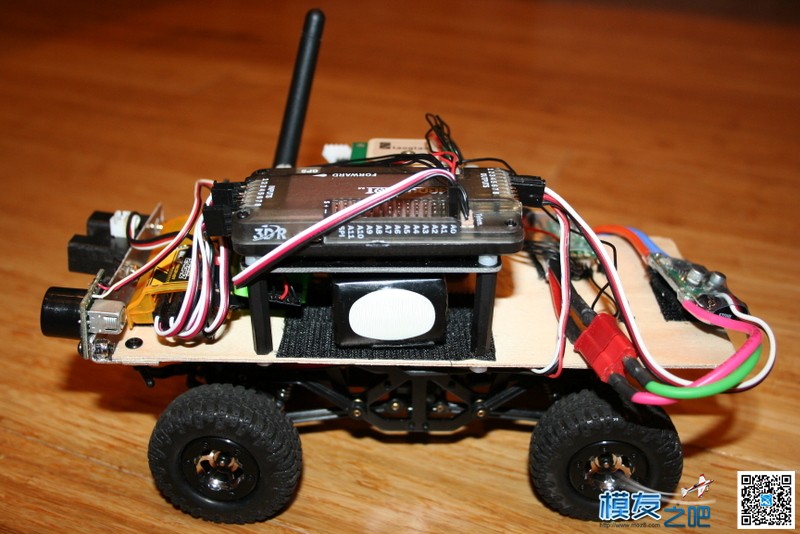
Depending on the car frame you’re using, you may wish to set up your gear differently. Almost any configuration can work, but just remember to keep APMas far from sources of magnetic interference as possible! The image below shows a top view of Tom Coyle’s Slash Rover (winner of the Peloton Class at AVC 2013) with a Spektrum receiver, GPS, and external compass.
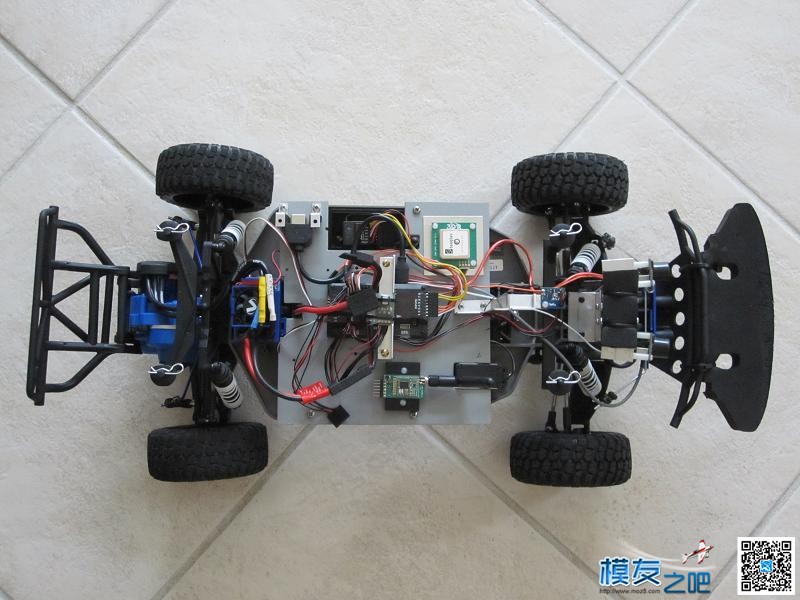
Connecting GPS ModuleA GPS module provides enhanced positioning for autonomous flight. Connecting your GPS to your autopilot by following these steps.
3DR GPS uBlox with Onboard Compass
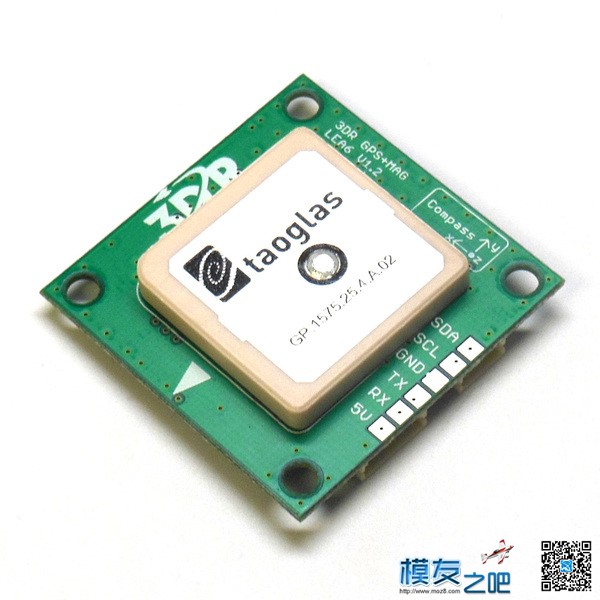 3DR GPS uBlox with Onboard Compass is intended for use with APM (for external compass). It provides enhanced compass performance because of the freedom to situate the GPS unit in an optimal position independent of the location of the APM.
3DR GPS uBlox with Onboard Compass is intended for use with APM (for external compass). It provides enhanced compass performance because of the freedom to situate the GPS unit in an optimal position independent of the location of the APM.Place your GPS in an elevated position on your rover with the arrow facing forward (toward the front facing direction of your rover). Connect the GPS module to the APM using the two cables included with the GPS as shown below.
3DR GPS uBlox with Onboard Compass includes two connector cables: one 4-position cable and one 5-position-to-6-position cable. To connect the GPS module to APM, connect the GPS to the APM GPS port using the 5-position-to-6-position cable; connect the GPS to the APM I2C port using the 4-position cable.
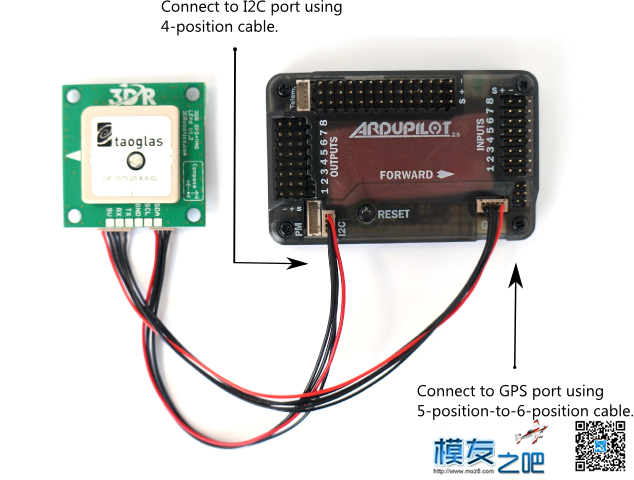
Slash Rover’s GPS with external compass mount:
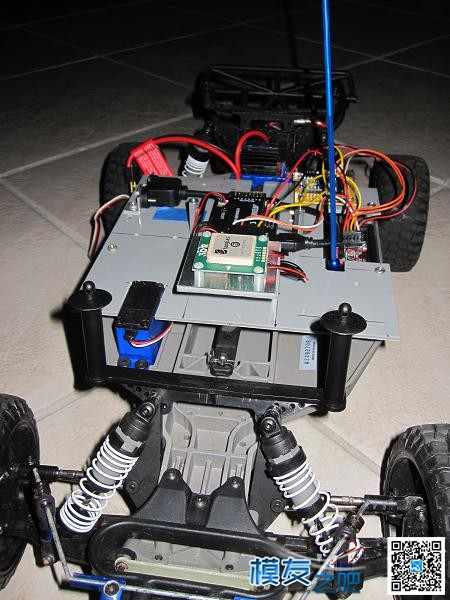
|